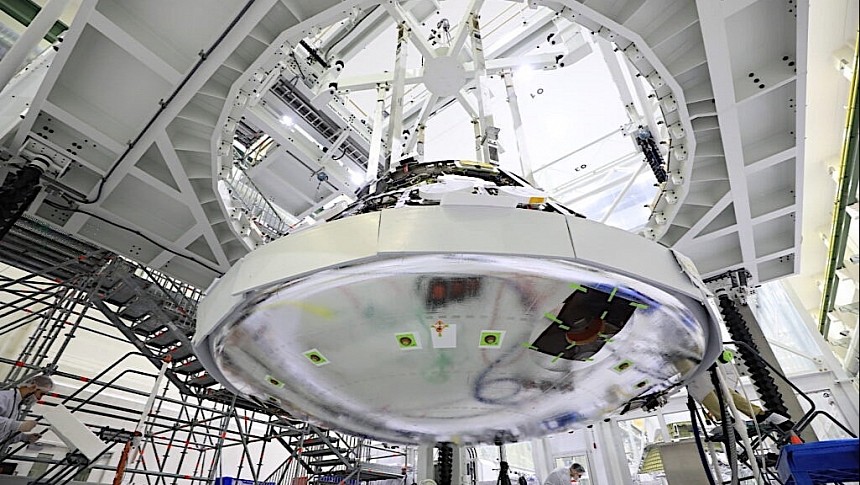If looked at simplistically, space exploration by means of spacecraft is only truly dangerous in two key moments: during liftoff and at re-entry. And that's why a lot of effort goes into making sure nothing bad happens during these phases of this mission.
Like all other spaceflights before it, the first crewed mission of the Artemis Moon exploration program will have to go through these two phases. Safe liftoff will be made possible by means of the Space Launch System (SLS) rocket, while the trip itself falls on a spacecraft called Orion.
Both the SLS and the Orion proved they could work safely during the Artemis I test mission of last year, but given how none of these pieces of hardware are reusable, new ones are currently being made.
On the Orion front, the latest news concerns the fitting of the spacecraft's heat shield. That's the bit of hardware meant to protect the vehicle and its occupants during the re-entry stage of the flight, when the ship comes back down to Earth.
Just like pretty much all other heat shields before it, this one too will have to withstand punishing heat caused by friction, reaching values as high as 5,000 degrees Fahrenheit (2,760 Celsius). That's almost half as hot as the Sun.
The heat is generated by the spacecraft rubbing against our planet's atmosphere as it descends at speeds of 25,000 mph (40,233 kph). The ship will of course not speed that fast all the way down. In just minutes, the spacecraft will slow down to a more manageable 300 mph (483 kph) on account of friction, and that always results in incredible heat.
Despite the high speed and high temperature, the people inside the spacecraft will only experience around 70 degrees Fahrenheit (21 degrees Celsius). And it's all owed to the said heat shield.
The 16.5 feet (5 meters) piece of hardware is made of a new interpretation of the ablative Avcoat material that was also used on the Apollo module. We're talking about tiles one to three inches thick, back in some sensitive places by a second ablator material called 3-Dimensional Multifunctional Ablative Thermal Protection System (3DMAT).
Now that the heat shield has been installed, NASA will move to gift the spacecraft with some of its external panels, opening the doors for acoustic testing later in the summer. Despite the name, acoustic tests are not meant to check how much noise the ship and its occupants can take, but how much vibration.
After that's done, the ship's service module, the one that includes the main engine, will be installed.
The Artemis II mission is tentatively scheduled to lift off in November 2024. It will carry a crew of four on a trip around the Moon to the farthest point from Earth any human has ever traveled: 6,400 miles (10,300 km) beyond the satellite.
Both the SLS and the Orion proved they could work safely during the Artemis I test mission of last year, but given how none of these pieces of hardware are reusable, new ones are currently being made.
On the Orion front, the latest news concerns the fitting of the spacecraft's heat shield. That's the bit of hardware meant to protect the vehicle and its occupants during the re-entry stage of the flight, when the ship comes back down to Earth.
Just like pretty much all other heat shields before it, this one too will have to withstand punishing heat caused by friction, reaching values as high as 5,000 degrees Fahrenheit (2,760 Celsius). That's almost half as hot as the Sun.
The heat is generated by the spacecraft rubbing against our planet's atmosphere as it descends at speeds of 25,000 mph (40,233 kph). The ship will of course not speed that fast all the way down. In just minutes, the spacecraft will slow down to a more manageable 300 mph (483 kph) on account of friction, and that always results in incredible heat.
Despite the high speed and high temperature, the people inside the spacecraft will only experience around 70 degrees Fahrenheit (21 degrees Celsius). And it's all owed to the said heat shield.
The 16.5 feet (5 meters) piece of hardware is made of a new interpretation of the ablative Avcoat material that was also used on the Apollo module. We're talking about tiles one to three inches thick, back in some sensitive places by a second ablator material called 3-Dimensional Multifunctional Ablative Thermal Protection System (3DMAT).
Now that the heat shield has been installed, NASA will move to gift the spacecraft with some of its external panels, opening the doors for acoustic testing later in the summer. Despite the name, acoustic tests are not meant to check how much noise the ship and its occupants can take, but how much vibration.
After that's done, the ship's service module, the one that includes the main engine, will be installed.
The Artemis II mission is tentatively scheduled to lift off in November 2024. It will carry a crew of four on a trip around the Moon to the farthest point from Earth any human has ever traveled: 6,400 miles (10,300 km) beyond the satellite.









